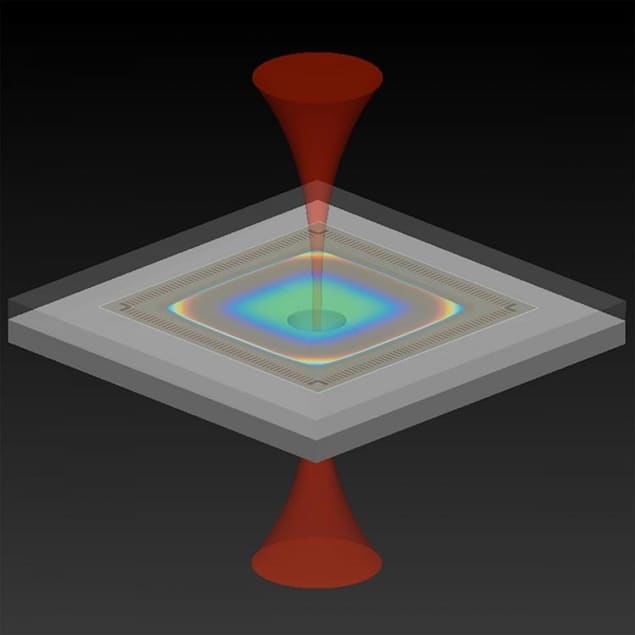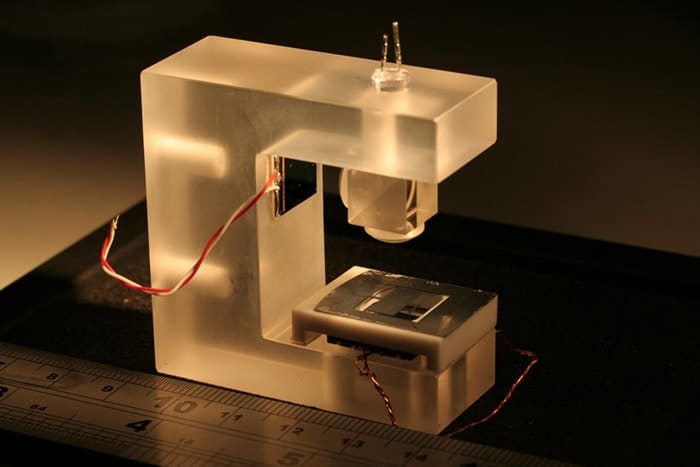
An accelerometer that uses laser light instead of just mechanical strain can register changes as small as tens of billionths of the acceleration due to Earth’s gravity, making it far more sensitive than commercial devices. With further improvements, the developers of the new optomechanical sensor say it might be used to orient aircraft, satellites and submarines, and could even serve as a portable reference to calibrate accelerometers already on the market.
Accelerometers – sensors that detect sudden changes in velocity – have many applications. Among other things, they help trigger the deployment of airbags in cars, keep rockets and aeroplanes on the correct flight path, provide navigation for self-driving vehicles and rotate images so that they stay the right way up on your mobile phone. In general, they work by tracking the position of a freely moving “proof” mass with respect to a fixed reference point in the device. The distance between this proof mass and the reference changes whenever the device slows down, speeds up or switches direction, producing a signal that can then be detected.
Distance change between two micromirrors
The new accelerometer developed by Jason Gorman, Thomas LeBrun, David Long and colleagues at the US National Institute of Standards and Technology (NIST) uses infrared light to measure the change in distance between two micromirrors in a configuration known as a Fabry–Perot cavity. In their set-up, the proof mass is a single crystal of silicon with a mass of between 10 and 20 mg, and it is suspended from the first mirror using a set of 1.5 μm-thick flexible silicon nitride (Si3N4) beams. Being suspended in this way allows the proof mass to move freely, with nearly ideal translational motion. The second mirror, which is concave, acts as the accelerometer’s fixed reference point and thus cannot move.
When the team directs infrared laser light into the optical cavity, most frequencies of light are entirely reflected. However, light of a certain frequency can resonate – or bounce back and forth – between the two mirrors in the cavity, increasing its intensity. When the team makes the device accelerate, the proof mass displaces relative to the concave mirror, and this displacement produces a change in the intensity of light reflected from the cavity.
The NIST researchers track this change using a stable single-frequency laser “locked” to the cavity’s resonant frequency. By continually matching the laser’s frequency to the resonant frequency of the cavity, they can determine how much the device has accelerated. The result is a device that can sense displacements of the proof mass that are smaller than a femtometre (10–15 m) and detect accelerations as low as 3.2 × 10-8 g, where g is the acceleration due to Earth’s gravity. This is better than any accelerometer on the market today of comparable size and bandwidth, the team says.
A simple spring
While the concept of an optomechanical accelerometer may sound simple, being able to accurately convert the displacement of the proof mass into an acceleration has proved challenging. In the new work, however, the proof mass and supporting beams are designed so that they behave like a simple spring (or harmonic oscillator) that vibrates at a single frequency in the operating range of the accelerometer. This approach, say the researchers, makes the setup easy to model using first-principles calculations.

New gravimeter-on-a-chip is tiny yet extremely sensitive
Using this technique, which they report in Optica, Gorman, LeBrun, Long and colleagues extended their approach to achieve measurement uncertainties of around 1% over a wide range of resonating frequencies (from 100 Hz to 15 kHz). Their device also does not need to be calibrated before use since it uses laser light of a known frequency to measure acceleration. It might thus ultimately serve as a portable reference standard for other accelerometers on the market (all of which do need to be calibrated) and so help make them more accurate.
In the future, the NIST group plans to refine its system so that it can be deployed in the field as an accurate sensor and intrinsic standard for acceleration. “Work is also under way on advanced applications of the technology ranging from searches for new physics to medical diagnostics and satellite measurements for climate change studies,” LeBrun tells Physics World.



